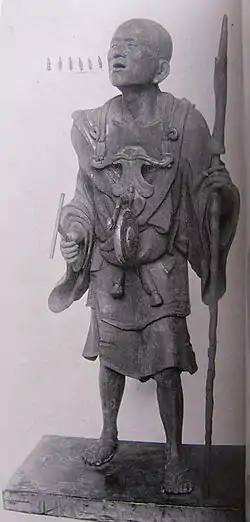Kūya
Kūya (空也; 903-972) was an itinerant Japanese Buddhist monk, or hijiri (聖), later ordained in the Tendai Buddhist sect, who was an early proselytizer of the practice of the nembutsu amongst the populace. Kuya's efforts helped promote the Pure Land teaching of Buddhism to the capital at a time when the movement was first gaining traction in Japan. For his efforts, Kuya earned the name ichi hijiri (holy man of the marketplace) and Amida hijiri.[12] Kūya was known for taking images with him on his travels and added musical rhythm and dance to his prayers, known as odori nembutsu.[13] Like Gyōki, he is said to have performed works for the public benefit such as building roads and bridges, digging wells, and burying abandoned corpses.[14][15][16]

Biographies of Kūya were written by his friends and followers Jakushin and Minamoto-no-Tamenori, and Number 18 of the Ryōjin Hishō derives from 'Kūya's Praise'.[14][17] The late tenth-century collection of biographies of those who had attained rebirth in the Pure Land, the Nihon ōjō gokuraki ki, attributes to Kūya the devotion of all Japan to the nembutsu.[16] He is also known as founder of Rokuharamitsu-ji where he later died.[18][12]
Details of Kuya's life are very scant prior to 938, but in the existing biographies it is said that Kuya, possibly of Imperial lineage, took tonsure at a temple in Owari Province in his youth and traveled to various holy sites and performing good works in the community.[12] Later, Kuya traveled to Awa and Tosa provinces before undertaking austerities at a place called Yushima (湯島) before a statue of Kannon. After attaining a vision of Kannon, he traveled to other provinces and eventually came to the capital in 938. Due to an ongoing revolt at the time, people from the provinces were displaced and came to the capital. Kuya was said to beg for food and then distribute that food to refugees and others who were suffering. Additionally, Kuya constructed Buddhist stupa and hanging scrolls depicting Kannon and Amitābha Buddha. Since his early years traveling the provinces, Kuya employed the nembutsu as a means of magically delivering the dead to the Pure Land, in contrast to the practice at the time where the dead were frequently left to decompose where they were left.[12]
Kuya was fully ordained as a monk in 948 in the Tendai Buddhist sect at Enryakuji temple on Mount Hiei,[12] and continued promoting the practice of the nembutsu while engaging in other activities. In 963, Kuya staged a grand ceremony to commemorate the completion of a copy, begun in 950 and relying on community donations, of the Mahaprajnaparamita Sutra composed in gold ink. Research suggests this sutra project was intended to relieve epidemics and pacify the spirits of the dead.[12] The biographies continue describing further miracles performed by Kuya until his death in 972.
Details of Kuya's religious beliefs are not explicitly explained in the biographies, but it is inferred from his actions that Kuya viewed the nembutsu as a form of thaumaturgy or miracle-working, as well as a form of salvation more common in later Pure Land teachings. Stories of hijiri itinerant monks (cf. Gyōki were common in the early Heian period, and Kuya is counted among them, but differs somewhat in his employment of the nembutsu as opposed to more widespread esoteric practices. Further, Kuya was not exclusively devoted to Amitābha Buddha, but venerated other Buddhist deities, particularly Kannon Bodhisattva.[12]
See also
- Pure Land Buddhism
- Jōdo shū
- Jōdo Shinshū
- Nembutsu
- Kanjin
References
- "Rokuharamitsuji - Important Cultural Properties". Rokuharamitsu-ji. Retrieved 20 April 2011.
- "Database of Registered National Cultural Properties". Agency for Cultural Affairs. Archived from the original on 26 March 2012. Retrieved 20 April 2011.
- Mōri, Hisashi (1977). Japanese Portrait Sculpture. Kodansha. pp. 83–85, 116. ISBN 0-87011-286-4.
- "Tsukinowa-dera". Blog (images and map). Retrieved 20 April 2011.
- "Database of Registered National Cultural Assets". Agency for Cultural Affairs. Archived from the original on 26 March 2012. Retrieved 20 April 2011.
- "Jōdoji Kūya". Matsuyama City. Archived from the original on 23 July 2011. Retrieved 20 April 2011.
- "Database of Registered National Cultural Properties". Agency for Cultural Affairs. Archived from the original on 26 March 2012. Retrieved 20 April 2011.
- "Shōgonji Kūya". Shiga Prefecture. Archived from the original on 21 July 2011. Retrieved 20 April 2011.
- "Database of Registered National Cultural Properties". Agency for Cultural Affairs. Archived from the original on 26 March 2012. Retrieved 20 April 2011.
- Mōri, Hisashi (1977). Japanese Portrait Sculpture. Kodansha. p. 65. ISBN 0-87011-286-4.
- Mōri, Hisashi (1974). Sculpture of the Kamakura Period. Weatherhill. pp. 126f. ISBN 0-8348-1017-4.
- Rhodes, Robert F.; Payne, Richard K. (2017). Genshin’s Ōjōyōshū and the Construction of Pure Land Discourse in Heian Japan (Pure Land Buddhist Studies). University of Hawaii Press. pp. 64–72. ISBN 0824872487.
- Moriarty, Elisabeth (1976). Nembutsu Odori, Asian Folklore Studies 35 (1), 7-16
- Hori, Ichiro (1968). Folk Religion in Japan: Continuity and Change. University of Chicago Press. pp. 106–8. ISBN 0-226-35334-6.
- Tamura, Yoshiro (2000). Japanese Buddhism: A Cultural History. Kosei Publishing. pp. 82–85. ISBN 4-333-01684-3.
- Hall, John Whitney (et al. edd.) (1999). Cambridge History of Japan Vol.II. Cambridge University Press. pp. 514, 574. ISBN 0-521-22353-9.
- Kim, Yung-Hee (1994). Songs to Make the Dust Dance. University of California Press. p. 49. ISBN 0-520-08066-1.
- "Rokuharamitsuji - History". Rokuharamitsuji. Retrieved 21 April 2011.
Further reading
- Chilson, Clark (2007). Eulogizing Kūya as More than a Nenbutsu Practitioner: A Study and Translation of the Kūyarui, Journal of the International Buddhist Association 34 (2), 305-327
